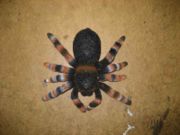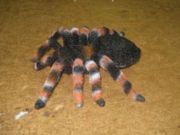Remote control tarantula
From DDL Wiki
(→Failure mode effects analysis) |
(→Failure mode effects analysis) |
||
| Line 192: | Line 192: | ||
==Design for manufacturing and assembly== | ==Design for manufacturing and assembly== | ||
==Failure mode effects analysis== | ==Failure mode effects analysis== | ||
| - | |||
| - | |||
==Design for environment== | ==Design for environment== | ||
Revision as of 00:01, 24 September 2007
Contents |
Executive summary
Customer needs
Function
The Tarantula is a variant of commonly seen remote controlled toys. The user holds a controller which sends radio signals to the Tarantula and controls its movement. The appeal of this toy is the novelty of a large moving spider as a remote controlled vehicle. Also, the realism of the device adds to the user’s enjoyment by allowing him or her to scare others with it.
Forward Locomotion
The controller only has two outputs, forward and back. During “forward” the motor runs in a clockwise direction engaging the drive wheels through a gear system. The drive wheels are under the head of the spider, and pivot to steer. A second set of wheels attached to the battery cover support the abdomen of the spider, but do not contribute to steering or propulsion. The drive wheels are vertically offset from each other to mimic a “crawling” motion and add to the realism. Due to the high gear ratio, the movement is slower than most RC toys, similar to what one would expect of an actual spider. However, the toy only functions well on very flat surfaces, and will become stuck on carpet or small obstacles.
Leg Movement
When the motor is engaged, a turn table in the head of the spider also spins. This table is cam shaped which causes it to asymmetrically engage 8 levers which are connected to the 8 legs of the spider. As the turn table engages the legs they are lifted up, but pulled back down by gravity as the turn table disengages them. This up and down motion of the legs mimics the crawling of a spider and it is central to the realism and novelty of the product.
Turning
The spider has no specific steering input form the remote control; rather it turns when the motor is running counterclockwise or receiving a “backwards” input. The drive wheels are setup such that depending on the direction the motor is running, the wheels will align to a certain orientation. The drive shaft for the wheels descends vertically from the head of the spider and connects to the drive wheels at a 90° angle. The bracket which holds the axle sits in two slots which allow it to rotate along the axis of the drive shaft. When the motor runs there is a net torque on the drive wheel axle, causing the bracket and axle to rotate if they are able. The wheels turn 45° relative to the centerline of the Tarantula if the motor is running backwards, and point straight ahead if the motor is running forwards. This causes the spider to turn while it is moving backwards, allowing the user to control the eventual destination of the device.
Power Train
The spider is powered by two AAA batteries connected in series. This powers the small motor and electronics (circuit board, LED eyes). The motor is connected to a gearing system with a large gearing ratio by a worm gear. This results in a slower movement, but higher torque on the drive wheels.
Product use
Components
| Part # | Part name | QTY | Function | Materials | Manufacturing Process | Picture |
|---|---|---|---|---|---|---|
| 001 | Cover Screws | 13 |
| Steel | Cold headed, Thread Rolled | 
|
| 002 | Inner Flat-headed screw | 2 |
| Steel | Cold headed, Thread rolled | 
|
| 003 | Battery Cover | 1 |
| Plastic | Injection Molded, hand modified | 
|
| 004 | Back Wheel housing | 1 |
| Plastic | Injection Molded | 
|
| 005 | Back Wheel | 2 |
| Plastic | Injection Molded, smoothed | 
|
| 006 | Small Leg | 4 |
| Plastic | Injection Molded | 
|
| 007 | Medium Leg | 2 |
| Plastic | Injection Molded | 
|
| 008 | Large leg | 2 |
| Plastic | Injection Molded | 
|
| 009 | Feelers | 2 |
| Plastic | Injection Molded | 
|
| 010 | Driving Wheel 1 | 1 |
| Plastic | Injection Molded, smoothed | 
|
| 011 | Driving Wheel 2 | 1 |
| Plastic | Injection Molded, smoothed | 
|
| 012 | Plastic Protection housing | 1 |
| Plastic | Injection Molded | 
|
| 013 | Back Wheel Axle | 2 |
| Steel | Cut wire, smoothed | Image:RC Tarantula Part 013.jpg |
| 014 | Battery Cover Washer | 1 |
| Plastic | Punched | Image:RC Tarantula Part 014.jpg |
| 015 | Gear 1 | 2 |
| Plastic | Injection Molded | 
|
| 016 | Gear 2 | 1 |
| Plastic | Injection Molded | 
|
| 017 | Gear 3 | 2 |
| Plastic | Injection Molded | 
|
| 018 | Gear 4 | 1 |
| Plastic | Injection Molded | 
|
| 019 | Axle 1 | 1 |
| Steel | Cut wire, smoothed | 
|
| 020 | Axle 2 | 1 |
| Steel | Cut wire, smoothed | 
|
| 021 | Axle 3 | 1 |
| Steel | Cut wire, smoothed | 
|
| 022 | Axle 4 | 1 |
| Steel | Cut wire, smoothed, stamped rough areas | 
|
| 023 | Axle 5 | 1 |
| Steel | Cut wire, smoothed, stamped rough areas | 
|
| 024 | Axle Cap | 1 |
| Plastic | Injection Molded | Image:RC Tarantula Part 024.jpg |
| 025 | Switch Assembly | 1 |
| Circuit Board (silicon), metal wires, plastic switch | Assembly | 
|
| 026 | Switch Cover | 1 |
| Plastic | Injection Molded | 
|
| 027 | Motor Assembly | 1 |
| Metal wiring, magnets, Metal casing, plastic gearing | Assembly | 
|
| 028 | Circuit Board Assembly | 1 |
| Circuit Board (silicon), metal wires | Assembly | 
|
| 029 | LED Assembly | 1 |
| Circuit (silicon), metal wires, LED | Assembly | 
|
| 030 | Tarantula exterior bottom | 1 |
| Plastic | Injection Molded, hand modified | 
|
| 031 | Tarantula exterior top | 1 |
| Plastic | Injection Molded, hand modified | 
|
| 032 | Battery Connector | 1 |
| Steel | Cut sheet metal | Image:RC Tarantula Part 032.jpg |
| 033 | Battery + connector | 1 |
| Steel | Cut sheet metal | Image:RC Tarantula Part 033.jpg |
| 034 | Battery - connector | 1 |
| Steel | Cut sheet metal | Image:RC Tarantula Part 034.jpg |
| 035 | Metal screw receiver | 1 |
| Steel | threaded cylinder | Image:RC Tarantula Part 035.jpg |
| 036 | Drive Wheel Mount | 1 |
| Plastic | Injection Molded | 
|
Design for manufacturing and assembly
Failure mode effects analysis
Design for environment
EIOLCA
The amount of environmental impact attributable to a single Tarantula is relatively negligible. But when the large volume of numbers produced is taken into account, the amount of pollutant emissions, economic demands, and energy needs become a larger factor to consider. The apparently environmentally harmless product becomes more a larger problem when considered in the grander scale of manufacturing and production.
The method used to calculate the environmental and economic impact of the Tarantula involves the use of data provided through the Economic Input-Output Life Cycle Assessment (EIO-LCA) database. In order to get a proper appreciation of the impact of the product, all calculations and measurements are done in terms of millions of dollars of economic activity. The database compiles information pertaining to the economic demands, pollutants emitted, energy demands, even the labor needs for certain sectors of different industries. Once a sector’s impact is calculated, the information pertaining to the contributing factors for each million dollars of activity can be accessed and compared.
Production of the Tarantula pertains primarily to sector 33930 - Dolls, Toys, and Game Manufacturing. However, over the lifetime of the product’s use, multiple purchases of batteries are required. As a result, the economic and environmental impact of the product is also linked to sector 335912 - Primary Battery Manufacturing. The focus of this analysis is to observe the main sources of emissions and demand for energy. The types of emissions observed are greenhouse gases, conventional air pollutants, and toxic releases.
For sector 33930, the primary consumer of energy is power generation itself. It consumes nearly three times the energy as the next two sectors, which are toy manufacturing and paperboard mills. These three sectors combined contribute for approximately half of the total energy required, amounting to 3.99 TJ/$1 Million for Production. The non-toxic emissions produced are also primarily attributable to power generation. However, the toxic releases caused by sector 33930 stem from the chemical nature of the type of manufacturing methods used. Of the 46.4kg/$1M, approximately 20 kg is caused by toy manufacturing and plastics material manufacturing.


